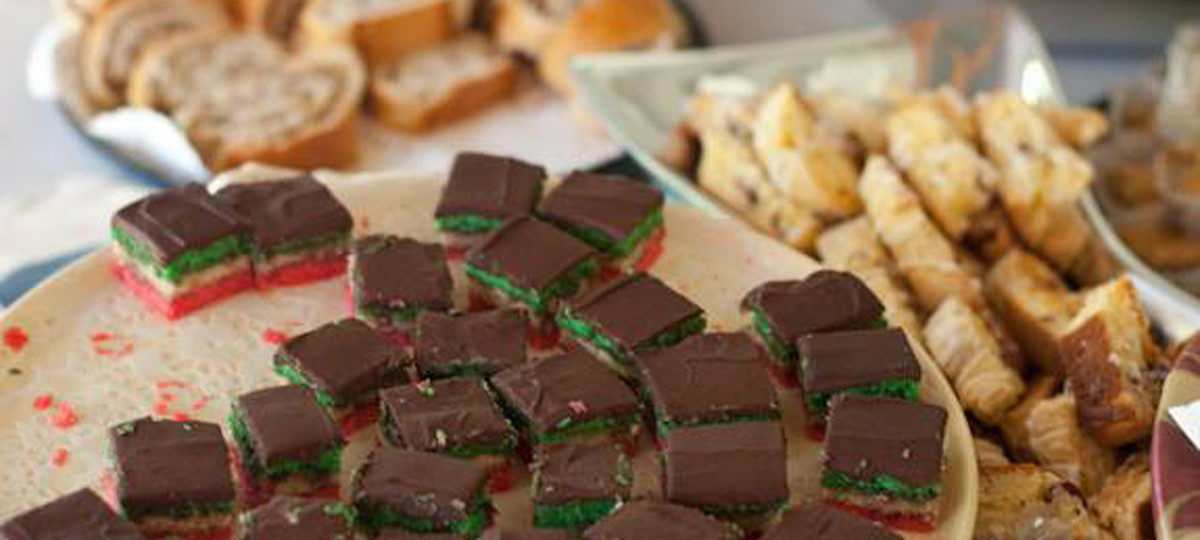
PITTSBURGH — Barb Yavorcik's husband jokes that when he called his mother to tell her they were engaged, she hung up the phone and turned the oven on to preheat. Why? "To bake the cookies for the wedding, of course," she said.
In certain parts of the country, particularly in Pittsburgh and Youngstown, Pennsylvania, where the Yavorcik family came from, if you do not have a cookie table at your wedding reception — actually, several tables ready to greet your guests — you may as well expect nothing short of a revolt. Or at least lifelong judgment and gossip about "that wedding."
"Nobody wants that shame brought to their name," said Christina Blasi, who had a bountiful cookie table at her Pittsburgh wedding. "Everyone makes different types of cookies, and once complete, they come together to be a massive assortment of deliciousness."
In short, the cookie table is everything. No matter if the wedding is held at a fire hall, a social club banquet hall, a high-end hotel or a beach, and no matter how inconvenient it might be, if you are from the Rust Belt, you will find a way to bring homemade cookies and display them artfully at your wedding.
For the generations who made up America's melting pot and their children, grandchildren and great-grandchildren, the cookie table is more important than the cake, what is served for dinner or what kind of dress the bride wore.
It is a tradition whose origin is not entirely clear but involves months of preparation, several hundred pounds of sugar, butter and flour, a variety of nuts and a sense of pride and connection to the past.
With every cookie you make, you know you are continuing a custom started by your mother's mother's mother as a way to showcase your family's culinary prowess. Oftentimes you are using their same recipes, some with notes written in the cookbook in their native language, and most of them with smudges of butter or molasses in at least one of the page corners.
The story goes that during the great migration of the 20th century, when a massive influx of laborers and their families migrated from Poland, Croatia, Czechoslovakia, Italy, Greece and Serbia to work in Pennsylvania, Ohio, West Virginia and Michigan, they were too poor to host elaborate weddings for their children. They found that the only way they knew how to show off their family heritage for the wedding was to make elaborate cookies — hundreds, or even thousands, of them.
They would enlist their mothers, aunts, sisters and neighbors, and the baking would go on for weeks. Sheets would be laid out on card tables as dozens of women rolled, kneaded and decorated in an assembly line of dusty flour, espresso and, eventually, wine. There would be laughter, gossip, squabbles and children sneaking in for a taste of sugary dough or icing.
Many placed their finished confectionaries in their fruit cellars, not just so they would not spoil but also so that no one was tempted to eat them before the big day. The day before the wedding, they would enlist every family member and neighbor to help them bring boxes and boxes of cookies, and they would spend hours artfully displaying them on a series of tables at the reception hall.
The end result was a point of pride. As guests walked into the reception, they were greeted with several long tables filled with colorful cookies stacked and waiting to be judged first, if only mentally, and then eaten.
It is a tradition that is very much alive today with one slight variation: Every family provides a to-go box. Back then, the extras were wrapped up in a napkin and taken home in grandma's or mother's pocketbook.
The only hard-and-fast rule: No store-bought or bakery cookies.
When 25-year-old Chelsea Marrie of Lowellville, Ohio, interned in Washington, D.C., none of her friends had ever even heard of a cookie table.
"It made me really miss home, but at the same time appreciate that I come from a place where family and friends aren't just people who see every once in a while, but people you share your life with," she said.
Lowellville is a small working-class village along the Mahoning River just northwest of Youngstown, where almost everyone has family members who worked at Sharon Steel Corp. and are of Italian decent.
When Wellsville, Ohio, native Dane Dysert started planning his wedding to Steve Wood earlier this year, he said, "I didn't care too much about a lot of details but was adamant that we have a cookie table." His fiance is from New England and had never heard of the tradition until they went to a big Italian wedding in Ohio in 2012.
Cultures and traditions of other countries have always been part of the American experience and the American fabric; it's why we go to ethnic festivals in the summer and fall to take a peek at other countries' foods and celebrations.
The cookie table tradition was started here by immigrants as a way to connect not just with their past but also with the new country they were starting to call home. Yes, it was a way to show off. But it was also a way to welcome. Deep friendships and community ties began at those kitchen tables and card tables that the women labored over 100 years ago. The remarkable thing is they still do.
Salena Zito is a CNN political analyst, and a staff reporter and columnist for the Washington Examiner. She reaches the Everyman and Everywoman through shoe-leather journalism, traveling from Main Street to the beltway and all places in between.


 Contact The Editor
Contact The Editor
 Articles By This Author
Articles By This Author